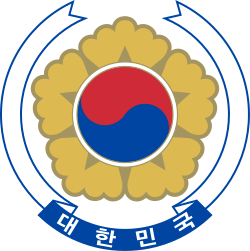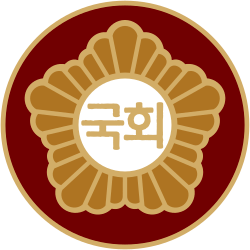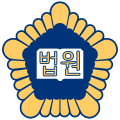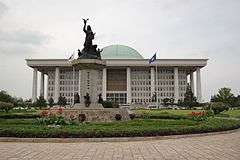Politics of South Korea
.svg.png)
 |
|---|
| This article is part of a series on the politics and government of the Republic of Korea |
| Constitution |
|
Judiciary |
The politics of the Republic of Korea takes place in the framework of a presidential representative democratic republic, whereby the President is the head of state, and of a multi-party system. Executive power is exercised by the government. Legislative power is vested in both the government and the National Assembly. The Judiciary is independent of the executive and the legislature and comprises a Supreme Court, appellate courts and a Constitutional Court. Since 1948, the constitution has undergone five major revisions, each signifying a new republic. The current Sixth Republic began with the last major constitutional revision in 1987.
The Economist Intelligence Unit has rated South Korea as the 20th most democratic country in 2017, the highest ranked Asian country and above Belgium, France or the United States.[1]
National government
Executive branch
| Office | Name | Party | Since |
|---|---|---|---|
| President | Moon Jae-in | Democratic Party | 10 May 2017 |
| Prime Minister | Lee Nak-yeon | Democratic Party | 31 May 2017 |
The head of state is the president, who is elected by direct popular vote for a single five-year[2] term. The president is Commander-in-Chief of the armed force of South Korea and enjoys considerable executive powers.
The president appoints the prime minister with approval of the National Assembly, as well as appointing and presiding over the State Council of chief ministers as the head of government. On 12 March 2004, the executive power of then president Roh Moo-hyun was suspended when the Assembly voted to impeach him and Prime Minister Goh Kun became an Acting President. On 14 May 2004, the Constitutional Court overturned the impeachment decision made by the Assembly and Roh was reinstated.
On 10 March 2017, Park Geun-hye became the first president to be removed by the Constitutional Court after impeachment by the National Assembly. Prime Minister Hwang Kyo-ahn temporarily served as an acting president between the suspension of Park since 9 December 2016 until the next presidential election, which was held in May 2017. On 9 May 2017, Moon Jae-in became the 19th president of South Korea, replacing acting president Hwang Kyo-ahn.
Legislative branch
The National Assembly (국회, 國會, gukhoe) has 300 members, elected for a four-year term, 253 members in single-seat constituencies and 47 members by proportional representation. The ruling Democratic Party of Korea is the largest party in the Assembly.
Judicial branch
The South Korean judiciary is independent of the other two branches. The highest judiciary body is the Supreme Court, whose justices are appointed by the president with the consent of the National Assembly. In addition, the Constitutional Court oversees questions of constitutionality. South Korea has not accepted compulsory ICJ jurisdiction.
Political parties and elections
South Korea elects on national level a head of state – the president – and a legislature. The president is elected for a five-year term by the people. The National Assembly (Gukhoe) has 300 members, elected for a four-year term, 246 members in single-seat constituencies and 54 members by proportional representation.
The main political parties in South Korea are the liberal Democratic Party of Korea (lit. "Together Democratic Party", DPK), the conservative Liberty Korea Party (LKP), the centrist People's Party (PP), and the left-wing Justice Party (JP), etc.
The liberal camp and the conservative camp are the dominant forces of South Korean politics at present.
| Group | Floor leader | Seats | % of seats | |
|---|---|---|---|---|
| Democratic | Hong Young-pyo | 129 | 43.14% | |
| Liberty Korea | Kim Sung-tae | 112 | 37.46% | |
| Bareunmirae | Kim Kwan-young | 30 | 10.03% | |
| Democracy and Peace | Chang Byoung-wan | 14 | 4.68% | |
| Justice | Yun So-ha (Acting) | 5 | 1.67% | |
| Minjung | - | 1 | 0.33% | |
| Korean Patriots' | - | 1 | 0.33% | |
| Independents | 7 | 2.34% | ||
| Total | 299 | 100.0% | ||
|
Notes:
| ||||
Political nature
South Korea's political history has always been prone to splits from and merges with other parties. One reason is that there is greater empathise around the 'politics of the person' and rather than party, therefore party loyalty is not strong when disagreements occur. The graph below illustrates the extent of the political volatility within the last 10 years alone. These splits were intensified after the 2016 South Korean political scandal.
.png)
Latest elections
| Party | Constituency | Party list | Total seats |
+/– | |||||||
|---|---|---|---|---|---|---|---|---|---|---|---|
| Votes | % | Seats | +/– | Votes | % | Seats | +/– | ||||
| Democratic Party of Korea (더불어민주당) (DPK) 1 | 8,881,369 | 37.0 | 110 | 6,069,744 | 25.5 | 13 | 123 | ||||
| Saenuri Party (새누리당) (SP) 2 | 9,200,690 | 38.3 | 105 | 7,960,272 | 33.5 | 17 | 122 | ||||
| People's Party (국민의당) (PP) | 3,565,451 | 14.9 | 25 | (new) | 6,355,572 | 26.7 | 13 | (new) | 38 | (new) | |
| Justice Party (정의당) (JP) 3 | 395,357 | 1.6 | 2 | 1,719,891 | 7.2 | 4 | 6 | ||||
| Christian Liberal Party (기독자유당) (CLP) | 1,376 | 0.0 | 0 | (new) | 626,853 | 2.6 | 0 | (new) | 0 | (new) | |
| Minjoo Party (민주당) (MP) 4 | 17,034 | 0.1 | 0 | (new) | 209,872 | 0.9 | 0 | (new) | 0 | (new) | |
| Other parties | 257,879 | 1.1 | 0 | 818,773 | 3.4 | 0 | 0 | ||||
| Independents | 1,683,264 | 7.0 | 11 | N/A | 11 | ||||||
| Total | 24,002,420 | 100.0 | 253 | 23,760,977 | 100 | 47 | 300 | ||||
| Turnout: 58.0%[5] | |||||||||||
Seat changes are compared to previous election, not the outgoing Assembly
1 Comparison based on 2012 Democratic United Party result
2 Comparison includes members elected in 2012 for the Liberty Forward Party
3 Comparison based on 2012 Unified Progressive Party result
4 Non-parliamentary grouping: not to be confused with the larger Minjoo Party of Korea, more usually referred to as the Minjoo Party
| Candidate | Party | Votes | % | ||
|---|---|---|---|---|---|
| Moon Jae-in | Democratic | 13,423,800 | 41.08 | ||
| Hong Jun-pyo | Liberty Korea | 7,852,849 | 24.03 | ||
| Ahn Cheol-soo | People's | 6,998,342 | 21.41 | ||
| Yoo Seung-min | Bareun | 2,208,771 | 6.76 | ||
| Sim Sang-jung | Justice | 2,017,458 | 6.17 | ||
| Cho Won-jin | Saenuri | 42,949 | 0.13 | ||
| Kim Min-chan | Independent | 33,990 | 0.10 | ||
| Kim Sun-dong | People's United | 27,229 | 0.08 | ||
| Chang Sŏng-min | Grand National United | 21,709 | 0.06 | ||
| Yoon Hong-sik | Hongik | 18,543 | 0.05 | ||
| Lee Kyung-hee | Korean Nationalist | 11,355 | 0.03 | ||
| Lee Jae-oh | Evergreen Korea | 9,140 | 0.02 | ||
| Oh Young-guk | Economic Patriot | 6,040 | 0.01 | ||
| Invalid/blank votes | 135,733 | – | |||
| Total | 32,807,908 | 100 | |||
| Registered voters/turnout | 42,479,710 | 77.23 | |||
| Source: National Election Commission | |||||
Political pressure groups and leaders
- Federation of Korean Industries
- Federation of Korean Trade Unions
- Korean Confederation of Trade Unions
- Korean National Council of Churches
- Korean Traders Association
- Korean Veterans' Association
- National Council of Labor Unions
- National Democratic Alliance of Korea
- National Federation of Farmers' Associations
- National Federation of Student Associations
Administrative divisions
One Special City (Teukbyeolsi, Capital City), six Metropolitan Cities (Gwangyeoksi, singular and plural), nine Provinces (Do, singular and plural) and one Special Autonomous City (Sejong City).
- Seoul Teukbyeolsi (서울특별시)
- Busan Gwangyeoksi (부산광역시)
- Daegu Gwangyeoksi (대구광역시)
- Incheon Gwangyeoksi (인천광역시)
- Daejeon Gwangyeoksi (대전광역시)
- Gwangju Gwangyeoksi (광주광역시)
- Ulsan Gwangyeoksi (울산광역시)
- Gyeonggi-do (경기도)
- Gangwon-do (강원도)
- Chungcheongbuk-do (충청북도)
- Chungcheongnam-do (충청남도)
- Jeollabuk-do (전라북도)
- Jeollanam-do (전라남도)
- Gyeongsangbuk-do (경상북도)
- Gyeongsangnam-do (경상남도)
- Jeju Teukbyeoljachi-do (제주특별자치도)
- Sejong Teukbyeol-jachisi (세종특별자치시)
International organization participation
AfDB, APEC, AsDB, BIS, CP, EBRD, ESCAP, FAO, G-77, IAEA, IBRD, ICAO, ICCt, ICC, ICRM, IDA, IEA (observer), IFAD, IFC, IFRCS, IHO, ILO, IMF, IMO, Inmarsat, Intelsat, Interpol, IOC, IOM, ISO, ITU, ITUC, MINURSO, NAM (guest), NSG, OAS (observer), OECD, OPCW, OSCE (partner), UN, UNCTAD, UNESCO, UNIDO, UNMOGIP, UNOMIG, UNU, UPU, WCO, WHO, WIPO, WMO, WToO, WTrO, Zangger Committee
References
- ↑ solutions, EIU digital. "Democracy Index 2017 - The Economist Intelligence Unit". www.eiu.com. Retrieved 2018-06-06.
- ↑ "Korea, South". The World Factbook. Central Intelligence Agency. Retrieved 30 May 2017.
- ↑ "4.13 총선" (in Korean). Naver News. 13 April 2016. Retrieved 13 April 2016.
- ↑ "개표진행상황" (in Korean). Republic of Korea National Election Commission. 14 April 2016. Retrieved 14 April 2016.
- ↑ "20대 총선 잠정투표율 58.0%…19대보다 3.8%p↑" (in Korean). Yonhap News. 13 April 2016. Retrieved 13 April 2016.



